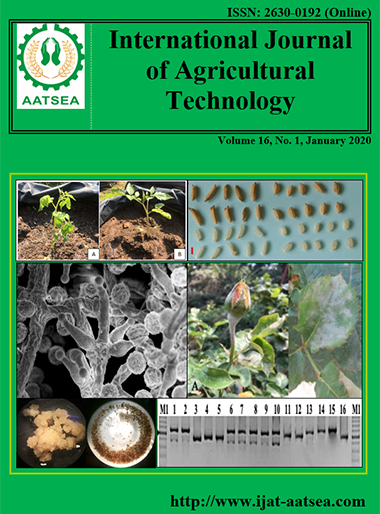Efficiency of antifungal compounds against powdery mildew disease of rose (Podosphaera pannosa)
Main Article Content
Abstract
The Powdery mildew on rose caused by the fungus Podosphaera pannosa is a serious problem in comercial rose garden. All aerial parts of the plant can be infected with the production of white mycelium containing conidiospores. Conidiospores can be dispersed by wind or rain to healthy plants. Infection is promoted by high humidity or where poor air movement occur in dryer environments. In this experiment, we observed a rose powdery mildew that was found in rose cultivar “Queen Sirikit” using a light microscope. The morphological characteristics of the anamorph revealed mycelium with indistinct or nipple-shaped appressoria, conidia with fibrosin bodies that measured approximately 6 to 8 x 17 to18 μm and fuliginea-type germtubes. Conidiophores were straight, ca. 5 to 7 x 41 to 80 μm with cylindrical foot-cells. The efficacy of antifungal compounds salicylic acid (SA), fresh cow’s milk (10%/V.) and some biocontrol agents: the bacterium Bacillus subtilis (BS) and the hyperparasitic fungus Ampelomyces sp. were compared with the conventional fungicide carbendazim using an onion tissue bioassay. The results showed that SA inhibited conidia germination by 99.72% followed by BS (98.99%), Ampelomyces sp. (95.41%), carbendazim (83.24%) and the last was fresh cow’s milk by 80.81%. The control treatment had 100% spore germination. The potential of the antifungal compounds was assessed in a greenhouse experiment and SA was a superior treatment to reduce the severity of disease (57.78%).
Article Details

This work is licensed under a Creative Commons Attribution-NonCommercial-NoDerivatives 4.0 International License.
References
Anderson, M.. D., Chen, Z. and Klessing, D. F. (1998). Possible involvement of lipid peroxidation in salicylic acid-mediated induction of PR-1 gene expression. Phytochemistry, 47:555-566.
Argus, C. R., Marcelo, M. and Robson, M. P. (2015). Antifungal activity of salicylic acid against Penicillium expansum and its possible mechanisms of action. International Journal of Food Microbiology, 215:64-70.
Belanger, R. R. and Labbe, C. (1994). Commercial scale control of rose powdery mildew with fungal antagonists. Plant Disease, 78:420-424.
Bettiol, W. (1999). Effectiveness of cow’s milk against zucchini squash powdery mildew (Sphaerotheca fuliginea) in greenhouse conditions. Crop Protection, 18:489-492.
Bettiol, W., Silva, H. S. A and Reis, R. C. (2008). Effectiveness of whey against zucchini squash and cucumber powdery mildew. Scientia Horticulturae, 117:82-84.
Biswas, S., Teotia, R. S. and Manal, S. K. (1992). Some field observations on the severity of powdery mildew (Phyllactinia corylea) in mulberry. Indian Journal of Science, 31:67-69.
Braun, U., Cook, R. T. A., Inman, A. J. and Shin, H. D. (2002). The taxonomy of powdery mildew fungi. In ‘The Powdery Mildews: A Comprehensive Treatise’. (Eds) R.R. B’elanger, W.R. Bushnell, A.J. Dik and T.L.W. Carver, pp.13-55 (St. Paul: APS Press).
Carlo, P., Ferdinando, D., Paolo, C. and Maria, L. (1997). Effectiveness of antifungal compounds against rose powdery mildew (Sphaerotheca pannosa var. rosae) in glasshouses, Crop Protection, 16:251-256.
Cook, R. T. A. and Braun, U. (2009). Conidial germination patterns in powdery mildews. Mycological Research, 113:616-636.
Crisp, P., Wicks, T. J., Bruer, D. and Scott, E. S. (2006). An evaluation of biological and abiotic controls for grapevine powdery mildew. 2. Vineyard trials. Australian Journal of Grape and Wine Research, 12:203-211.
Diego, R., Antonio, de V., Rivo, H. R., Samuel, E. D., Jan-Willem, V., Eva, A., Francisco, M. C., Oscar, P. K., Michel, P. and Alejandro, P. (2007). The iturin and fengycin families of lipopeptides are key factors in antagonism of Bacillus subtilis toward Podosphaera fusca. The American Phytopathological Society, 20:430-440.
Hashioka, Y. and Nakai, Y. (1980). Ultrastructure of pycnidial development and mycoparasitism of Ampelomyces quisqualis parasitic on Erysiphales. Transactions of the Mycological Society of Japan, 21:329-338.
Hirata, K. (1942). On the shape of the germ tubes of Erysiphaceae. Bull Chiba College of. Horticulture, 5:34-39.
Horvath, E., Pal, M., Szalai, G., Paldi, E. and Janda, T. (2007). Induction of abiotic stress tolerance by salicylic acid signaling. Journal of Plant Growth Regulation, 26:290-300.
Kiss, L. (1998). Natural occurace of Ampelomyces intracellular mycoparasites in mycelia of powdery mildew fungi. New Phytopathology, 140:709-714.
Linde, M. and Shishkoff, N. (2003). Disease: Powdery Mildew. Encycopedia of Rose Science: pp.158-165, DOI: 10.1016/B0-12-227620-5/00068-9.
McGrath, M. T. (1991). Reduced effectiveness of triadimefon for controlling cucurbit powdery mildew associated with fungicide resistance in Sphaerotheca fluttginea. Phytopathology, 81:1191.
Nair, K. R. S. and Ellingboe, A. H. (1962). Method of controlled inoculations with conidiospores of Erysiphe graminis var. tritici. Phytophthology, 52:714.
Pasini, C., Ferdinando, D., Paolo, C. and Maria, L. G. (1997). Effectiveness of antifungal compounds against rose powdery mildew (Sphaerotheca pannosa var.rosae) in glasshouses. Crop Protection, 6:251-256.
Paulitz, T. C. and Bélanger, R. B. (2001). Biological control in greenhouse systems. Annual Review of Phytopathology, 39:103-133.
Reuveni, M. and Reuveni, R. (1995). Efficacy of foliar application of phosphates in controlling powdery mildew fungus on field-grown winegrapes: effects on cluster yield and peroxidase activity in berries. J. Phytopathology, 143:21-25.
Shishkoff, N. and McGrath, M. T. (2002). AQ10 biofungicide combined with cheical fungicides or AddQ spray adjuvant for control of cucurbit powdery mildew in detached leaf culture. Plant Disease, 86:915-918.
Stadnik, M. J. and Bettiol, W. (2001). Pulverizacăo com leite estimula a microflora do filoplano ereduz a severidade do oídio do pepino. Summa Phytopathology, 27:109.
Sudisha, J., Kumar, A., Amruthesh, K. N., Niranjana S. R. and Shetty, H. S. (2011). Elicitation of resistance and defense related enzymes by raw cow milk and amino acids in pearl millet against downy mildew disease caused by Sclerospora graminicola. Crop Protection, 30:794-801.
To-anun, C. and Takamatsu, S. (2007). Powdery mildews in genus Oidium subgenus Friboidium of Thailand: Integrated analyses of morphological and molecular characteristics. Proceedings of the Internatinal Conference on Integration of science and Technology for Sustainable Development (ICIST) “Biological Diversity, Food and Agricultural Technology”. April 26-27, 2007. KMITL, Bangkok. Thailand, pp.251-258.
Townsend, G. R. and Heuberger, J. W. (1943). Methods for estimating losses caused by diseases in fungicide experiments. Plant disease reporter, 27:340-343.
Yardwood, C. E. (1932). Ampelomyces quisqualis on clover mildew. Phytopathology, 22:31.
Yardwood, C. E. (1939). Control of powdery mildews mildews with a water spray. Phytopathology, 29:382-384.


